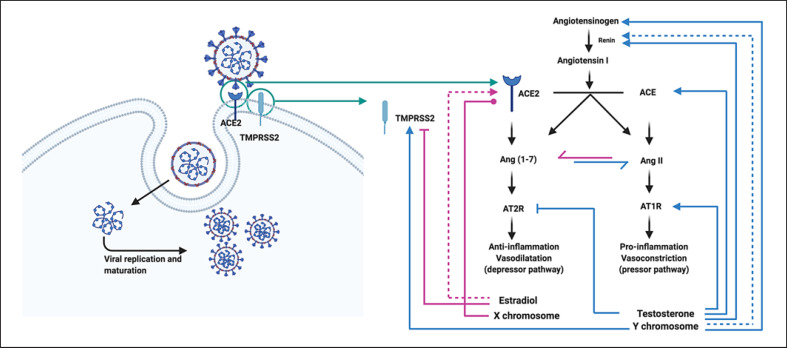Fig. 2.
Sex chromosome and sex hormone regulation of TMPRSS2 and ACE2 expression and activity, and implications in RAS function. ACE2 and TMPRSS2 are stechiometrically contiguous and mediate SARS-CoV-2 cell fusion and entry. ACE2, being an X-linked gene, should be supposed to be more expressed in female tissue (pink line with dot). However, despite being an X-linked gene escaping from X inactivation, ACE2 displays a male-biased expression in several tissues. Subsequently to membrane fusion and virus entry into the host cell, SARS-CoV-2 infection leads to downregulation of ACE2. As a result, the ACE2/Ang(1-7)/AT2R axis is markedly attenuated, with amplification of the pressor ACE/AngII/AT1R axis. Sex chromosome and sex hormones contribute to RAS regulation. In males, sex hormones and genes in sex chromosomes contribute by differentially modulating the RAS. Specifically, testosterone upregulates the expression of angiotensinogen and AT1R (blue line with arrow), reduces the expression of AT2R (blue line with inhibitor), and concomitantly inhibits renin activity (blue dashed line with arrow). Moreover, SRY genes upregulate angiotensinogen, renin, and ACE expression (blue line with arrow) and downregulate ACE2 expression (blue line with inhibitor). These effects upregulate the classical constrictor and proinflammatory pathway ACE/AngII/AT1R axis. Moreover, testosterone positively regulates TMPRSS2 expression (blue line with arrow). In contrast, estradiol changes the balance towards depressor and anti-inflammatory ACE2/Ang(1-7)/AT2R axis increasing ACE2 activity (pink dashed line with arrow). Moreover, estradiol negatively regulates TMPRSS2 expression (pink line with arrow). Figure created with www.biorender.com. ACE, angiotensin-converting enzyme; ACE2, angiotensin-converting enzyme 2; Ang(1-7), angiotensin 1-7; AngII, angiotensin II; RAS, renin-angiotensin system; SARS-CoV-2, severe acute respiratory syndrome coronavirus 2; SRY, sex-determining region Y; TMPRSS2, transmembrane protease serine 2.

